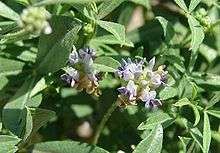Psoralidium lanceolatum
Psoralidium lanceolatum (syn. Ladeania lanceolata)[1] is a species of flowering plant in the legume family known by several common names, including lemon scurfpea, wild lemonweed, and dune scurfpea.[2]

| Psoralidium lanceolatum | |
|---|---|
 | |
| Scientific classification | |
| Kingdom: | |
| (unranked): | |
| (unranked): | |
| (unranked): | |
| Order: | |
| Family: | |
| Subfamily: | |
| Genus: | |
| Species: | P. lanceolatum |
| Binomial name | |
| Psoralidium lanceolatum | |
| Synonyms | |
| |
It is native to western North America from central Canada to California to Texas, where it grows in sandy habitat, such as alluvial plains[1] and sagebrush.[3]
It is a perennial herb with a branching, heavily glandular stem growing 30 to 60 centimeters tall. The leaves are palmately compound, each made up of usually three linear or lance-shaped leaflets borne on a short petiole. The inflorescence is a raceme of flowers emerging from a leaf axil. Each flower is under a centimeter long with a pealike corolla in shades of light purple-blue to white. The fruit is a hairy, glandular, spherical legume.[1]
The Zuni people eat the fresh flowers to treat stomachaches.[4]
References
- Ladeania lanceolata. Jepson eFlora.
- Psoralidium lanceolatum. Integrated Taxonomic Information System (ITIS).
- Laedeania lanceolata. Burke Museum, University of Washington.
- Camazine, Scott & Robert A. Bye (1980). "A study of the medical ethnobotany of the Zuni Indians of New Mexico". Journal of Ethnopharmacology. 2 (4): 365–388. doi:10.1016/S0378-8741(80)81017-8. PMID 6893476.